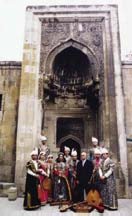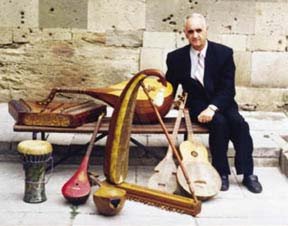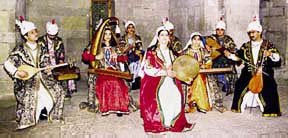|

Winter 1997 (5.4)
Pages
28-31
Piecing Together
History, String By String
The Reconstruction
of Azerbaijan's Medieval Instruments
by Jean Patterson
Related Articles
1. Music
Therapy
- What Doctors Knew Centuries Ago by Farid Alakbarov
2. Traditional
Instruments:
Majnun Karimov Brings Medieval Music to Life
Click here to hear a sound sample
  By studying manuscripts
and miniature art, musicologists have discovered that more than
60 different string, wind and percussion instruments existed
in ancient and medieval Azerbaijan. By studying manuscripts
and miniature art, musicologists have discovered that more than
60 different string, wind and percussion instruments existed
in ancient and medieval Azerbaijan.
Photo: The National Ensemble of Ancient Traditional
Musical Instruments in front of the Shirvanshah Palace in the
Inner City (Ichari Shahar). The musician's costumes are based on 14th century
miniature paintings.
They
know the names of most of these now-extinct instruments, such
as the "chang" mentioned by Azerbaijani poets like
Nizami. (The "chang" is featured on the cover of this
issue.) Until now, however, many details about these instruments
have eluded historians.
For the past 25 years, Azerbaijani musicologist Dr. Majnun Karimov
has been searching for the answers to questions about what these
instruments looked and sounded like. Through careful research
and study, he has literally pieced together a portion of Azerbaijani
musical history by recreating some of these ancient instruments.
1
Thanks
to Karimov, instruments such as the chang, barbat, chogur and
rubab can now be heard once again.
Chang and Barbat
One
of the greatest thrills in Majnun Karimov's music career took
place in 1988 at the 500th Jubilee (birthday) of Shah Ismayil
Khatai2 when an ensemble o
f musicians performed on medieval instruments that he, himself,
had reconstructed. It was a dream come true for Karimov to recreate
the sweet, melodious sounds of stringed instruments so that a
contemporary audience could appreciate. His work has become a
major contribution to the cultural history of Azerbaijan.
Majnun first
became interested in folk instruments as a young boy when his
mother brought her father's tar to their home. Mostly, it hung
on the wall in his house, but from time to time, his father would
take it down to play. Later, Majnun's father bought him an accordion.
His serious research on traditional Azerbaijani instruments began
in 1972 after he graduated from the Baku Music Academy. At that
time, he began searching the classical writings and art miniatures
for clues that would unlock the musical secrets of the past.
For several years, he researched the manuscripts at Azerbaijan's
National Manuscript Institute. Eventually in 1995, he completed
his Ph.D. thesis on "The Ancient Stringed Musical Instruments
of Azerbaijan."
Left: Chang, Center: Barbat, Right: The
National Ensemble of Ancient Traditional Musical Instruments
performing inside the Shirvanshah Palace in the Inner City (Ichari
Shahar) in Baku.
First Attempt
Karimov's
first attempt at building a replica was for the " rud "
(pronunciation rhymes with "food"), a large-bodied,
four-stringed instrument made partly of wood and partly of leather.
Similar to the "ud," the neck of the rud is longer.
The process took several months after much trial and error. "Sometimes
the measurements weren't right," Karimov confesses, "and
I would have to disassemble the whole thing and start all over
again. It took me so much time to prepare the strings which were
supposed to be made out of gut and silk thread using a special
technique. Then I had to figure out how to adjust them. Finally,
I was able to play it. The "rud" had such a beautiful
timbre reminiscent of a very old sound. It inspired me to push
on to work on other instruments."
  Left: Musicologist Majnun Karimov with eight of the
ancient instruments he has reconstructed. Left: Musicologist Majnun Karimov with eight of the
ancient instruments he has reconstructed.
And so he did.
Nine early instruments, completed during the 1980s, are currently
on display in the Ethnic Instruments Department of the State
Museum of Azerbaijani Musical Culture.
Thanks to Karimov's efforts, a special laboratory was opened
in 1991 at the Baku Music Academy to "restore and improve
old musical instruments."
Karimov insists that many factors must be considered when building
these instruments including the correct choice of timber, its
seasoning and moisture content. Even the time of year when the
tree is felled must be taken into account. The sap is lowest
in January and February. Wood that is full of sap can develop
cracks as it dries. Karimov notes that wood that has dense annual
rings produces a stronger sound.
There are two
ways to assemble instruments according to Karimov. One is to
fashion the parts separately and put them together as with the
"barbat." The other method is to plane a block of wood
down to the correct specifications as is done with the chang.
It's much easier to plane wet wood. Afterwards, the roughly hewn
wood is allowed to dry for a long time at a specific temperature.
A few years later, the wood is worked again. Finally, the frets
and stem are attached.
Karimov has found that the strength of the wood is particularly
important for the neck and fingerboard because of the pressure
caused by tuning. The fingerboard can become distorted if the
material is not strong enough. He recommends walnut and pear
pegs because they can withstand atmospheric factors of humidity
and temperatures and maintain stable tuning.
Various species of trees are used for these old instruments including
mulberry (Morus alba), walnut (Juglans regia), red willow (Salix
acutifolia), pear (Pyrus communis) and apricot (Prunus armenica).
The strings are mostly made of silk, horsehair or animal gut.
Sounding boards are usually made of mulberry or walnut and those
covered in leather create the greatest resonance. In addition
to sheep skin, sometimes fish skin, the Absheron gazelle skin
or even the inner lining of an animal heart is used.
Early Music
Evidence
shows that stringed instruments were common in ancient Azerbaijan.
Archeological excavations in the village of Shatirlar near the
city of Barda uncovered an earthenware piece dating between the
4th and 3rd century B.C. depicting a woman playing an instrument
similar to the chang.
Much of what we know about Azerbaijan's musical heritage during
the Middle Ages comes from folklore and classical poetry. Important
examples are the writings of poet and philosopher Nizami Ganjavi
(12th century), the poet Fuzuli (16th century) and the studies
of eastern musicologists Urmavi (13th century), Maraghayi (14th
century) and Navvab (19th century).
Maraghayi was
especially interested in the restoration and improvement of stringed
musical instruments. In his work "Magasid Al-Alhan,"
he provides information about numerous musical instruments such
as: udi gadim (old ud), udi kamil (improved ud), shashtay, kamancha,
jiganak, Shirvan tanbur, Turkish tanbur, rubab, shidirgi, shahrud,
mugni and nuzha.
Musical instruments were also depicted in miniature paintings
made by artists of the 16th and 17th centuries, such as Sultan
Muhammad Aga Mirek, Mirza Ali, Muzaffar Ali and Mir Sayid Ali.
These tiny pictures have become important documents for reconstructing
these instruments.
The question is always asked: What happened to these early instruments?
Innovation and changing times brought the demise of some of these
instruments. In other cases, instruments were adapted to fit
the needs of the time and older designs were replaced by new
ones. In some cases, a completely new instrument evolved. Many
musicians think that the "tar" originated from the
"chogur." The chogur had 22 frets and was used between
the 12th-18th centuries. Research shows that the chogur's assemblage
and sound structure of these two instruments were very similar.
Mirza Sadig Assadoglu ( Sadig -jan) modified the five string
tar to 13 strings. After his death in 1902, it was simplified
to 11 strings.
Chang and Barbat
Two
examples of instruments that Karimi has rebuilt are the chang
and the barbat. The chang is the forerunner of the harp and seems
to have been used extensively in medieval Azerbaijan. Some believe
that the chang was derived from a hunting weapon, such as a bow.
Its sounding board seems to resemble a fish. Like the harp, the
chang is plucked with the fingers of both hands.
Maraghayi wrote that the chang had leather stretched over the
sounding board, and that the strings, sometimes as many as 24,
were made of threads. In his article "Music and Dances of
the Ancient Turks," Dr. Faruk Sumer, who has studied the
ancient musical instruments of the Turkish peoples, mentions
that two changs were found during the excavation of the Altay
grave site in Turkey dating to 250-500 B.C. Legend suggests that
the chang was created by the Almighty. Actually, in some early
drawings, the chang is depicted as a holy angel.
The barbat is a member of the lute family, a pear-shaped stringed
instrument. Miniatures by the artist Mirza Ali show that its
body was bigger than that of the lute, and that it had a long
neck. Written sources tell us that the barbat was played much
like the ancient lute, although tuned according to different
intervals. The 12th century Azerbaijani poet Afzalagdin Khagani
wrote that the barbat had eight strings, was made of animal gut
and had four sound openings, called "four little stars."
Musicologist T. Vyzgo describes it as having an Arabic derivation,
originally called an "al-ud."
The barbat was chiefly played at palace feasts, often along with
the chang. Nizami describes the chang and the barbat as complementary
instruments: "Nekisa took up her chang, Barbad took up his
barbat. And the sounds resounded in winged harmony like a rose
in harmony with both color and fragrance. Barbat and chang, intoxicating
and robbing one's strength."
More Music to Come
It's
possible to hear these instruments being played again today in
Azerbaijan by the Ancient Instruments Ensemble, a group created
by the Folk Instruments Museum in 1996. Karimov is the director
of this 12-member ensemble. The group's repertoire includes folk
melodies as well as music written down by Urmavi and Maraghayi,
in an alpha-notational system based on what is known as the ABJD
system (pronounced "ahb-jad" which rhymes with the
word, "pad") . These four letters name the sequence
of first letters in the Arabic alphabeta lef, beh, jim, dal.
Each note was represented by a single letter or a letter combination
. For example, note 1 was "A," note 2 was "B,"
note 3 was "J," etc. As the progression continued,
letters were written in combination, such as "AA,"
"AB," "AJ," etc. Duration of notes was also
indicated.
With great effort, Shamil Hajiyev, a musicologist associated
with the Ensemble, has adapted a music computer program to transcribe
the alphabetic notational system and convert it into a melody
line.
To learn one of the old melodies, the members of the Ancient
Instrument ensemble listen to the melody line played on his computer
laptop and improvise the harmony for their various instruments.
Needless to say, it's a long and tedious process. English composer
and musicologist George Farmer (1882-1965) has also researched
Urmavi's works and deciphered some of these early melodies.
Work continues at Karimov's laboratory, as more ancient instruments
like the "golcha gopuz," the "nuzha" and
the "mugni" are being researched and restored. It is
Karimov's hope that research and restoration of the ancient folk
instruments will be able to continue until many of the mysteries
and harmonious sounds created in the past are available for contemporary
man to enjoy as well.
Majnun Karimov
is the
head of the Laboratory for the Reconstruction of Ancient National
Music Instruments, located in the basement of the Academy of
Music at 98 Shamsi Badalbeyli Street. Tel: (99-412) 98-69-72;
Home Tel: 91-95-48.
The Museum of Folk Instruments, located in the former residence
of the famous tar player, Ahmad Bakikhanov, is at Zargarpalan
119. Contact: Tapan Gaziyeva at (99-412) 94-60-62.
UP 1
The
medieval instruments described in this article are all stringed
instruments. They include barbat, chang, chogur, golcha gopuz,
gyjak, mugni, nuzha, rubab, rud, shashtay, Shirvan tanbur, shahrud,
shidirigi, Turkish tanbur , udi gadim (old ud ), udi kamil (improved
ud) and tar.
2 Shah
Ismayil was the founder of the Persian Safavid Dynasty (1501-1736).
An Azerbaijani, he lived in Ardabil (an Azerbaijani city located
today in Iran) and played a vital role in subjugating local tribes
and in unifying the fragmented Persian Empire. Shah Ismayil was
also the leader responsible for proclaiming Shi'i Islam the state
religion which, in turn, served to create a national consciousness
among the various racial elements of the region.
From Azerbaijan
International
(5.4) Winter 1997
© Azerbaijan International 1997. All Rights Reserved.
Back to Index
AI 5.4 (Winter 1997)
AI Home |
Magazine
Choice
| Topics
| Store
| Contact
us
|





